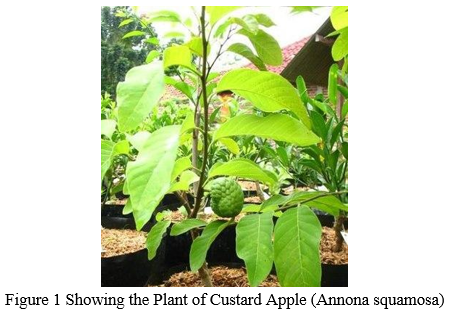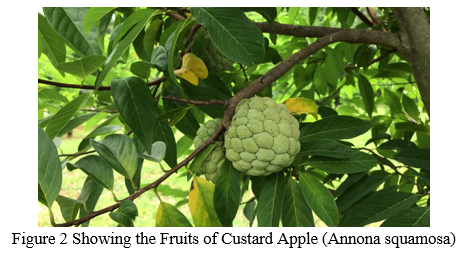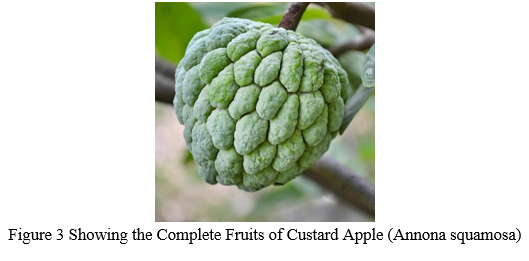Ijraset Journal For Research in Applied Science and Engineering Technology
- Home / Ijraset
- On This Page
- Abstract
- Introduction
- Conclusion
- References
- Copyright
Beneficial Aspects of Custard Apple (Annona squamosa): A Perspective Review
Authors: Ms. Neha, Ms. Tanya, Dr. Amit Kumar Dutta
DOI Link: https://doi.org/10.22214/ijraset.2022.40000
Certificate: View Certificate
Abstract
Custard apple is a wonderful desert fruit that is well renowned for its dessert and confectionary qualities. It is scientifically known as Annona squamosa. Annona squamosa is one of the most widely grown Annona species. The plant has also been shown to have various medical benefits, including antioxidant, anti-diabetic, anti-infective, and anti-dyslipidemic capabilities. The leaves are administered to Abscesses, insect bites, and other skin ailments as a vermicide and for treating malignant tumors. Toothaches are treated using root-bark scrapings. These seeds have long been utilized in folk medicine around the world. Custard apple seeds were traditionally used to cure a variety of digestive ailments as well as an insecticide. Custard apple seeds have been used as a traditional cure for lice and dandruff infestations on the scalp in our region of the world for many years. Surprisingly, there have been few cases of toxicity from these seeds, and the management is inefficient. Due to ocular exposure to custard apple seeds, two patients developed keratoconjunctivitis. Our series is highlighted to offer an alternative treatment for situations of custard apple seed injury. This research tries to bring together the nutritional worth and medical applications of custard in one place.
Introduction
I. INTRODUCTION
Custard apple, scientifically known as Annona squamosa L. which belongs to family Annonaceae, genus Annona and species reticulata, mostly known for its dessert and confectionary values, is one of the most important delicious and healthy arid fruits. (Meena et. al.; 2014)

The genus name ‘Annona’ came from the latin word ‘anon’ which means ‘yearly produce’. other related species are Annona reticulate and Annona cherimol. Custard apple is known by various name as sharifa, sugar apple and sitaphal. It has pine core with a scaly skin that is grey green. The white pulp interior contains huge black inedible seeds and has a creamy tropical flavor. It has a sweet flavor and is slightly acidic and has a pleasant texture. It has a height of almost 5-9 feet and is a subtropical small deciduous spreading tree with large green dropping leaves and trumpet shaped light yellow flowers and emits pungent sweet smell during late afternoon. Bearing starts at the age of 4 to 6 years and bearing stops after 12-15 years. As custard apple is rich in carbohydrates i.e 230gm/100gm and has a pleasant flavor so it is used in making ice cream .it is also included in diet foe weight gain for athletes because it has high calorie as compared to other fruits . It gives 104 Kcal per 100gm of edible portion (Dickson et al., 1975). It is mostly activated in dry climate. it can withstand mild frost .it does not require deep soil because root system is confined to relatively shallow layers, however it needs well drained soil.

A. Nutritive Value of Custard Apple
Custard apple which is mainly consumed as dessert fruit has numerous nutritive values. All 6 Table shows the nutritive value of custard apple per 100g of pulp. starch is present in rich amount when firm but sugar increases markedly as it softens. Mainly sugars are present are glucose and fructose (80%-90%). The calorific value is high i.e 300-450KJ per 100g and almost double that of apple, orange, or peach (Hansche et al ., 1963). Vitamin C anti-oxidants, which cures many diseases and also boosts immune system, is present in very high amount in custard apple. Vitamin C, Vitamin A, antioxidants, dietary fiber, magnesium, potassium is abundant in this fruit, also contains calcium, vitamin B6, copper and low fats levels, excellent source of iron (Hoser- Krauze et al., 1987) in the edible portion, 3.1% is fiber. Vitamin C, which is a great anti-oxidant present in this fruit helps in fighting free radicals in our body. It also protects us from blood pressure and cardiac diseases. As it rich in magnesium and potassium. It is even easily digestible at old age, which is a great advantage. Lethargies are removed by potassium in fruits which are sweet in taste, and it also makes human body active. It also helps to combat muscle weakness. Vitamin A, which helps in keeping hair and skin healthy, is present in this fruit. It is also essential for eyes and treats indigestion. This fruit should be added to our diet as it helps to cure constipation because it contains copper. Magnesium is rich in this fruit which will help in maintaining water balance in human body. It will also help in reducing the symptoms of arthritis and rheumatism, and also in removing acids from joints (Hundal et al., 1993).

Custard apple’s physio-chemical analysis was investigated in order to determine the fruit’s importance in foods and beverages (Chen et al., 2012). They found that pulp was a good source of protein (1.6%) and a source of carbs (23.9%). Custard apple juice was utilized to boost the quality of custard apple carbonated drinks. Custard apple carbonated beverages have a high nutritional value, indicating that they were a rich source of nutrients, Carbohydrates (12.9%), protein (0.7%), and fat (0.7%). Custard apple is high in natural sugar, making it a healthy snack that may also be used in sweets. Because the fruit has a high calorie content, it is often included in diets for weight gain and athletics. It has 104 calories per 100 grammes of edible portion.
|
Nutrients |
Amount |
|
Water |
183g |
|
Protein |
5.2g |
|
Ash |
1.9g |
Table 1 shows the Basic Components of Custard Apple Calories
|
Nutrients |
Amount |
|
Total Calories |
235 |
|
Calories from Fat |
6.1 |
|
Calories from Carbohydrates |
231 |
|
Calories from Protein |
17 |
Table 2 shows the Differential Components of Custard Apple Calories
|
Nutrients |
Amount |
|
Total Fat |
725 mg |
|
Saturated Fat |
120mg |
|
Monosaturated Fat |
285mg |
|
Polyunsaturated Fat |
100mg |
|
Omega-6-fatty Acids |
100mg |
Table 3 shows the Fats & Fatty Acids in Custard Apple
|
Nutrients |
Amount |
|
Total Carbohydrates |
59g |
|
Dietary |
11g |
Table 4 shows the Carbohydrates in Custard Apple
|
Nutrients |
Amount |
|
Vitamin A |
15 UI |
|
Vitamin C |
91mg |
|
Thiamin |
275mcg |
|
Riboflavin |
283mcg |
|
Niacin |
2.2mg |
|
Vitamin B6 |
500mcg |
|
Folate |
35mcg |
|
Pantothenic Acid |
565mcg |
Table 5 shows the Vitamins in Custard Apple
|
Nutrients |
Amount |
|
Calcium |
60g |
|
Magnesium |
53g |
|
Potassium |
618g |
|
Sodium |
23g |
|
Zinc |
250g |
|
Copper |
215mcg |
|
Iron |
1.5g |
|
Selenium |
1.5mcg |
|
Phosphorus |
80mg |
Table 6 shows the Minerals in Custard Apple
II. MEDICINAL VALUES OF CUSTARD APPLE
The Custard apple fruit has several health and medical benefits, and most of its plant components (Fruit, Seed, and Leaves) appear to contain significant bioactive elements. Anonaine, Aporphine, Coryeline, Isocorydine, Norcorydine, and Glaucine are some of the chemical compounds isolated from the plant’s leaves, stems, and roots. Ayurvedic practitioners in India have used various portions of the sugar apple (Annona squamosa) tree for the treatment of diabetes for ages. Custard apple essential oils and pinenes have also been described and extracted. Acetogenins are a class of compounds that distinguishes custard apples from other fruit species. The acetogenins, which are exceptionally long chain fatty acids found solely in Annonaceous species, are unique to the Annonaceous family. The anti-cancer and anti-hypertensive characteristics of the in vitro and in vivo investigations appear to be significant.

III. MEDICINAL PROPERTIES
A. Antioxidant Activity
The antioxidant activity in mature fruits of 36 Taiwanese species and varieties was assessed using the ferric reducing antioxidant power (FRAP) assay in the Taiwanese study (Chen et al., 2006). Sugar apple was classified as having very high antioxidant activity in this study, with >70mmol/100g edible part. Many studies, including those conducted in India (Wongs-Aree et al., 2011, Kaur et al., 2003), have demonstrated that extracts of Annona squamosa, Annona cherimola, and Annona muricata have high anti-oxidant activity.
B. Effects on Cardio-vascular Disease
Hole et al. investigated the effect of an aqueous extract of the fruits on isoproterenol-induced myocardial infarction in rats. Custard apple pulp pretreatment reduced myocardial damage (Hole et al., 2006). A quarter of a normal sized custard apple consumed daily by an 80 kg human exhibited cardioprotective effects comparable to therapeutic doses of captopril (Kaleem et al., 2006). In another study, custard apple pulp (2.5-5.0 g/kg body weight) reduced total cholesterol levels by 46 percent in normal rabbits and 32.4 percent in diabetic rabbits with increased HDL-cholesterol (Gupta et al., 2005). The rabbits’ triglyceride/ HDL ratio, which is a significant predictor of heart disease in humans (Gazino et al., 1997), was cut in half. (Beppu et al., 2009) demonstrated that oral administration of ethanol extracts of fresh custard apple fruit significantly reduced plasma levels. 65 percent of mice fed a moderately high fat diet for four weeks had higher triglyceride levels, and exhibited a potent adipogenesis inhibitory effect, reducing fat tissue by approximately 20%. The anti-dyslipidemic effect is important in the prevention of cardiovascular morbidity.
C. Anti-HIV Properties
Among the 14 isolated compounds studied, 16,17-dihydroxy-entkauran-19-oic acid demonstrated significant activity against HIV replication (Wu et al., 1996) in H9 lymphocyte cells with an EC50 value of 0.8 g/Ml.
D. Antidiabetic Properties
In rabbit studies, 5 g of semi-dried pulp of sugar apple per kg of body weight was found to be effective as an anti-diabetic supplement. In humans, this equates to eating one-eighth of a normal custard apple. The most likely mechanism could be due to increased Insulin sensitivity Custard apple appears to mimic anti-diabetic effects in animal studies. Insulin stimulates its production and increases the uptake of glucose by muscles, resulting in Blood sugar concentrations are stabilized. In fact, leaf extracts are also useful in Lowering blood glucose levels, and several studies show that Annona squamosa leaf Extract can effectively replace lower doses of externally administered insulin.
E. Anticancer Properties
The anti-cancer properties of custard apple appear to be primarily due to a class of compounds known as Acetogenins, which are unique to Annonaceae. Acetogenins have been shown to be effective against 60 different types of cancer cells in vitro. Breast, prostate, and colon cancer are just a few examples. When compared to the standard anti-cancer drug paclitaxel, Even in an in vivo test system, bullatacin, an acetogenin, was 300 times more potent. Annonaceous acetogenins also inhibit complex I enzymes in the mitochondrial electron transport system. They also inhibit the NADH oxidases found in the plasma membranes of tumor cells. The Acetogenins inhibit MDR (Multi Drug Resistance) expression and induce apoptosis of cancer Cells. Bullatacin extracted from custard apple is 258 times more cytotoxic against breast cancer cell than Adriamycin.
F. Anti-infective
The fruit of Annona spp. has been shown to have anti-microbial properties due to a variety of compounds including Ent-kauranes, Acetogenins, essential oils, and Benzylisoquinolines alkaloids. The crude methanol extract of sugar apple and an isolated diterpene are being tested for anti-bacterial activity against Staphylococcus aureus and Streptococcus pneumonia. There have also been reports of chemicals that are active against Candida albicans, proteus, and other pathogens (Wiart et al., 2005).
G. Other Properties
Other than the fruity part of the plant, other parts of the plant have been found to be medicinal. In vivo, aqueous extracts of Anona squamosa seeds demonstrated significant antitumor activity against AK-5 tumour. Gupta et al. in 2005 found that feeding sugar apple pulp to animals increased haemoglobin levels by up to 21%.
The bark of Annona species has been used to extract roemerolidine and duguevalline alkaloids. They demonstrated moderate Antiplasmodial (Antimalarial) activity with no cytotoxicity. Alkaloids, Dopamine, Salsolinol, and Coclaurine are also found in the leaves and stems.
Magnesium aids in the maintenance of the body’s water balance. It may benefit arthritic patients by removing acids from joints. Custard apple contains copper, which helps with constipation.
IV. BENEFITS OF CUSTARD APPLE
A. Helps in Weight Gain
Custard apples are an excellent snack and dessert for folks looking to gain weight. The carbohydrates in this calorie-dense fruit boost the metabolic rate, which in turn stimulates appetite levels. The more your appetite, the better your food intake. As a result, you may be able to gain weight.
B. Boosts Immune System
Custard apples are high in Vitamin C, which is a natural antioxidant. This vitamin is also known for its immune-boosting and anti-inflammatory qualities. Add one serving of this luscious fruit to your daily diet to boost your immune system's resistance to infectious invaders. It prevents the beginning of different illnesses and disorders by scavenging damaging free radicals in the body.
C. Improves our Brain Health
Custard apple is high in B vitamins, which regulate GABA nerve chemical levels in the brain. This relieves stress, tension, and irritation.as well as depression It also guards against Parkinson's disease. Vitamin C is found in 0.6 grammes per 100 grammes of custard apple. B6, which accounts for roughly 20% of the daily required amount value.
D. Can Help to Avoid Anemia
Custard apple contains a lot of iron, which is great for treating anemia. The fruit is beneficial in the treatment of nausea, gout, and vitamin B6 deficiency.
E. Rich in Iron
Custard apple is high in iron, which lowers the chance of a baby being born prematurely. It lessens the severity of labor pain in expecting mothers. It is also referred to as enhance the amount of milk produced by pregnant and nursing women.
F. Very Effective for Digestive System
This fruit is a great way to get rid of indigestion. It eliminates toxins from the gut. helping to keep the bowels in good working order. In addition, heartburn, ulcers, and other stomach-related disorders are prevented acidity and gastritis.
G. keeps Dental System Strong
Due to its creamy texture, Custard Apple is often eaten with a spoon and served chilled like custard. Custard Apple has a sweet taste similar to other tropical fruits, such as banana and pineapple and Custard apple skin is beneficial in the treatment of gum and tooth pain.
V. BENEFITS OF CUSTARD APPLE FOR SKIN
A. Good for Skin Rejuvenation
Custard apple is not only a tasty fruit, but it is also beneficial to the skin. It contains nutrients such as vitamin C, vitamin A, vitamin B, and antioxidants, all of which are necessary for skin rejuvenation.
B. Naturally Heals the Skin Infections
Custard apple paste is used to treat ulcers, abscesses, and boils. Custard Apple contains vitamin C, which aids in wound healing and the formation of cartilage, tendons, and ligaments. Consuming custard apple juice on a regular basis promotes the growth of new cells in the skin’s layers. It also helps with the healing of abrasions and cuts. When applied to the skin, the latex of the custard apple tree treats skin diseases such as inflammation, eczema, and psoriasis.
C. Keeps Skin Cancer Away
The custard apple is believed to be a native of the West Indies but it was carried in early times through Central America to southern Mexico. Custard Apple’s acetogenin compounds aid in the removal of pre-cancerous skin lesions, thereby preventing skin cancer.
D. Lowers Pigmentation Problems
Custard apple reduces brown spots and pigmentation by decreasing the clustering of melanin granules. It also aids in the reversal of pigmentation caused by free radicals.
E. Good for Pimple-Prone Skin
Custard apple consumption reduces sebum production, thereby controlling acne and pimples. To control sebum production, combine custard apple paste and lemon juice and apply three times per week. Custard apple’s anti-inflammatory properties fight acne and clear the pores to prevent future breakouts.
F. Natural Detoxifying Agent
Custard apple is high in soluble fiber and antioxidants, making it a good laxative. Custard apple consumption on a regular basis helps in the removal of toxins and waste, resulting in healthy and glowing skin. Drinking custard apple juice evens out the skin tone and firms it up, giving it a more youthful appearance.
VI. BENEFITS OF CUSTARD APPLE FOR HAIR
Custard apple contains essential nutrients such as iron, magnesium, vitamin A, and phosphorus, all of which can benefit the hair in a variety of ways.
- Aids in the Elimination of Lice
- Improve Collagen Levels
- Natural Scalp Infection Treatment
- For Silky, Moisturized Hai
- To Promote Hair Growth
VII. EXTRACTION OF OIL FROM CUSTARD APPLE SEEDS
Bitter and toxic, the seeds are used as fish poison and pesticides. Fruit flies and liars were found to be attracted to the custard seed, which has insecticidal effects. Seed pest is used to cure cancer. The majority of the acetogenins were discovered from the seeds of custard apple(Annona squamosa), which had outstanding cytotoxic and abortifacient properties (Chitodkar et al., 2014).
VIII. PROCESS FOR OIL EXTRACTION
A. Materials
- Two necked round bottom flask ( verity traders, Amravati)
- Condenser (Chemical Engg. Dept. Ytl)
- Heating mental (Chemical Engg. Dept. Ytl)
- Thermometer (Chemical Engg. Dept. Ytl)
- Beaker 500 ml (Chemical Engg. Dept. Ytl)
- Measuring cylinder (Chemical Engg. Dept. Ytl)
- Weighing Balance (Chemical Engg. Dept. Ytl)
- Seed Crusher (Chemical Engg. Dept. Ytl)
- Oil Seed Sample (Obtain from Custard Apple)
- Solvents (Butanol, Benzene- Variety Traders, Amt)
B. Method
The seeds of the custard apple were crushed and ground to the required size. In a two-neck round bottom flask linked to a vertical condenser, the crushed and powdered powder was combined with Butane as a solvent. This combination was heated for approximately 3-4 hours at a temperature of 700C. The solvent was utilised in a 15 ml/g seeds powder ratio. The condensate was maintained for 2 hours after distillation to settle. The intended product, oil, was removed from the top layer. The method was then repeated with benzene as the solvent.
IX RESULT AND DISCUSSION
|
Solvent |
Wt. of Sample (in gm) |
Volume of Solution (in ml) |
Volume of Oil Extracted (in ml) |
|
Butanol |
21 |
250 |
13.5 |
|
Benzene |
21 |
250 |
3 |
It is observed that butanol extracts a greater amount of oil than benzene.
The following conclusions were reached after conducting a study on the extraction of oil from custard apple seeds using Butanol and benzene-
- Butanol out per forms Benzene in terms of efficiency.
- It may also be used as an insect repellent, pesticide and weedicide, in pharmaceuticals, and in bio production. If properly processed, the by-product of the processing could be useful for plant or animal feed.
Conclusion
Custard apple, which is a fruit of Annona squamosa have variety of nutritional values, properties, medicine properties, including antioxidant, anti-diabetic, anticancer, anti-HIV etc. There are various benefits of this fruit for human body as well as for human skin. Even the seeds are used for the production of oil which are used as insect repellent, pesticide and weedicide etc.
References
[1] Beppu, F., Niwano, Y., Kyan, R., Yasura, K., Tamaki, M., Nishino, M., & Hamada, H. (2009). Hypolipidemic effects of ethanol extracts of Citrus depressa and Annona atemoya, typical plant foodstuffs in Okinawa, Japan on KKAy mice fed with moderately high fat diet. Food Science and Technology Research, 15(5): 553- 556. [2] Chen, B., Zhang, X., & Geng, S. (2012). A new hot pepper F1 hybrid-\'Jingla No. 8\'. China Vegetables, 22: 94- 96. [3] Chen, T., Wen-Ju Yang, Ning-Sing Shaw, and Tzong-Shyan Lin. (2006). Antioxidant activity of fruits produced in Taiwan. Abstract. In 27th International Horticultural Congress, Korea. [4] Chitodkar, V. D., & Srivastav, R. P. S. (2014). Anti-head lice ointment from Custard Apple Seed Oil. Int. J Research. Advent Tech, 9(2): 83- 85. [5] Dickson, M. H. (1975). G1117A, G1102A, and G1106A Cytosterile broccoli inbreds. HortScience, 10: 535. [6] Gaziano, J. M., Hennekens, C. H., O’Donnell, C. J., Breslow, J. L., & Buring, J. E. (1997). Fasting triglycerides, high-density lipoprotein, and risk of myocardial infarction. Circulation, 96(8): 2520- 2525. [7] Gupta, R. K., Kesari, A. N., Watal, G., Murthy, P. S., Chandra, R., & Tandon, V. (2005). Nutritional and hypoglycemic effect of fruit pulp of Annona squamosa in normal healthy and alloxan-induced diabetic rabbits. Annals of Nutrition and Metabolism, 49(6): 407- 413. [8] Gupta, R. K., Kesari, A. N., Watal, G., Murthy, P. S., Chandra, R., & Tandon, V. (2005). Nutritional and hypoglycemic effect of fruit pulp of Annona squamosa in normal healthy and alloxan-induced diabetic rabbits. Annals of Nutrition and Metabolism, 49(6): 407- 413. [9] Hansche, P. E., & Gabelman, W. H. (1963). Digenic Control of Male Sterility in Carrots, Daucus carota L. Crop Science, 3(5): 383- 386. [10] Hole, R., Wakade, A., Juvekar, A., Nachankar, R., & Kulkarni, M. (2006). Protective effect of Annona reticulata L. fruits on isoproterenol induced myocardial infarction in rats. In International Congress, Phytopharm, St. Petersburg, Russia. [11] Hoser-Krauze, J., & Antosik, J. (1987). Horticultural value and seed setting of cytoplasmic male sterile cauliflower line with Raphanus sativus CMS (Bannerot). Eucarpia Cruciferae Newsl, 12: 34. [12] Hundal, J. S., & Khurana, D. S. (1993). CH-1. A new hybrid of chilli. Progressive Farming, 29: 11- 13. [13] Kaleem, M., Asif, M., Ahmed, Q. U., & Bano, B. (2006). Antidiabetic and antioxidant activity of Annona squamosa extract in streptozotocin-induced diabetic rats. Singapore Medical Journal, 47(8): 670. [14] Kaur, C., & Kapoor, H. C. (2003). Antioxidant activity of some fruits in Indian diet. In VII International Symposium on Temperate Zone Fruits in the Tropics and Subtropics, 2: 563- 565. [15] Meena, O. P., & Meena, N. K. (2014). Role of Hybrids in Vegetable Production. Popular Kheti, 2(3): 7- 14. [16] Wiart, C., Au, T. S., Mohd, Y., Hassan, H., & Sulaiman, M. (2005). 16 ? Hydroxy-(-)-kauran-19-oic Acid: An Antibacterial Diterpene from Sweet Apple (Annona squamosa L., Annonaceae). International Journal of Pharmacology, 1(3): 296- 298. [17] Wongs-Aree, C., & Noichinda, S. (2011). Sugar apple (Annona squamosa L.) and Atemoya (A. cherimola Mill.× A. squamosa L.). In Postharvest Biology and Technology of Tropical and Subtropical Fruits. Woodhead Publishing, 1: 399- 427. [18] Wu, Y. C., Hung, Y. C., Chang, F. R., Cosentino, M., Wang, H. K., & Lee, K. H. (1996). Identification of ent-16?, 17-dihydroxykauran-19-oic acid as an anti-HIV principle and isolation of the new diterpenoids annosquamosins A and B from Annona squamosa. Journal of Natural Products, 59(6): 635- 637.
Copyright
Copyright © 2022 Ms. Neha, Ms. Tanya, Dr. Amit Kumar Dutta. This is an open access article distributed under the Creative Commons Attribution License, which permits unrestricted use, distribution, and reproduction in any medium, provided the original work is properly cited.

Download Paper
Paper Id : IJRASET40000
Publish Date : 2022-01-19
ISSN : 2321-9653
Publisher Name : IJRASET
DOI Link : Click Here
 Submit Paper Online
Submit Paper Online

